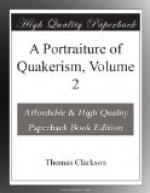But this spirit is considered by the Quakers not only as teaching by inward breathings, as it were, made immediately and directly upon the heart without the intervention of outward circumstances, but as making the material objects of the Universe, and many of the occurrences of life, if it be properly attended to, subservient to the instruction of man; and that it enlarges the sphere of his instruction in this manner, in proportion as it is received and encouraged. Thus the man, who is attentive to these divine notices, sees the animal, the vegetable, and the planetary world, with spiritual eyes. He cannot stir abroad, but he is taught in his own feelings, without any motion of his will, some lesson for his spiritual advantage; or he perceives so vitally some of the attributes of the divine being, that he is called upon to offer some spiritual incense to his maker. If the lamb frolics and gambols in his presence as he walks along, he may be made spiritually to see the beauty and happiness of innocence. If he finds the stately oak laid prostrate by the wind, he may be spiritually taught to discern the emptiness of human power; while the same spirit may teach him inwardly the advantage of humility, when he looks at the little hawthorn which has survived the storm. When he sees the change and the fall of the autumnal leaf, he may be spiritually admonished of his own change and dissolution, and of the necessity of a holy life. Thus the spirit of God may teach men by outward objects and occurrences in the world; but where this spirit is away, or rather where it is not attended to, no such lesson can be taught. Natural objects of themselves can excite only natural ideas: and the natural man, looking at them, can derive only natural pleasure, or draw natural conclusions from them. In looking at the Sun, he may be pleased with its warmth, and anticipate its advantages to the vegetable world. In plucking and examining a flower, he may be struck with its beauty, its mechanism, and its fragrant smell. In observing the butterfly, as it wings its way before him, he may smile at its short journeys from place to place, and admire the splendour upon its wings. But the beauty of Creation is dead to him, as far as it depends upon connecting it spiritually with the character of God. For no spiritual impression can arise from any natural objects, but through the intervention of the spirit of God.




